AUDI A4 CABRIOLET 2009 Owners Manual
Manufacturer: AUDI, Model Year: 2009, Model line: A4 CABRIOLET, Model: AUDI A4 CABRIOLET 2009Pages: 340, PDF Size: 77.32 MB
Page 271 of 340

__________________________________________________ T_ ir_e_ s_ a_ n_d _ w_ h_ e_ e_l_s _ ...... lJII
•
Curb weight
means the weight of a motor vehicle with standard equipment
including the maximum capacity of fue l, oi l, and coolant, air condi
tioning and additional weight of optional equipment.
Extra load tire
means a tire designed to operate at higher loads and at higher infla
tion pressures then the corresponding standard tire . Extra load tires
my be identified as "XL", "xi", "EXTRA LOAD", or "RF" on the side
wa ll.
Gross Axle Weight Rating ("GAWR")
means the load-carrying capacity of a single axle system, measured
at the tire -ground interfaces.
Gross Vehicle Weight Rating ("GVWR ")
means the maximum total loaded weight of the vehicle.
Groove
means the space between two adjacent tread ribs.
Load rating (code)
means the maximum load that a tire is rated to carry for a given
inflation pressure. You may not find this information on al l tires
because it is not required by law.
Maximum load rating
means the load rating for a tire at the maximum permissible infla
tion pressure for that tire.
Maximum loaded vehicle weight
means the sum of :
(a) Curb weight
(b) Accessory weight
(c) Vehicle capacity we ight, and
(d) Product ion options weight
Maximum (permissible) inflation pressure
means the maximum cold inflat ion pressure to which a tire may be
inflated. Also called "maximum inflation pressure."
Normal occupant weight
means 150 lbs. (68 kilograms) times the number of occupants
seated in the vehicle up to the total seating capacity of your vehicle.
Occupant distribution
means distribution of occupants in a vehicle.
Outer diameter
means the overall diameter of an inflated new tire.
Overall width
means the linear distance between the exteriors of the sidewalls of
an inflated tire, including elevations due to labeling, decorations, or
protective bands or ribs.
Ply
means a layer of rubber -coated para lle l cords .
Production options weight
means the combined weight of those installed regular production
options weighing over 5 lbs. (2 .3 kg) in excess of those standard
items which they replace, not previously considered in curb weight
or accessory weight, including heavy duty brakes, ride levelers,
heavy duty batter y, and special trim.
Radial ply tire
means a pneumatic tire in which the ply cords that extend to the
beads are laid at substantially 90 degrees to the centerline of the
tread.
Recommended inflation pressure
see::;, page 268, "Cold tire inflation pressure".
Ve hic le care
Page 272 of 340
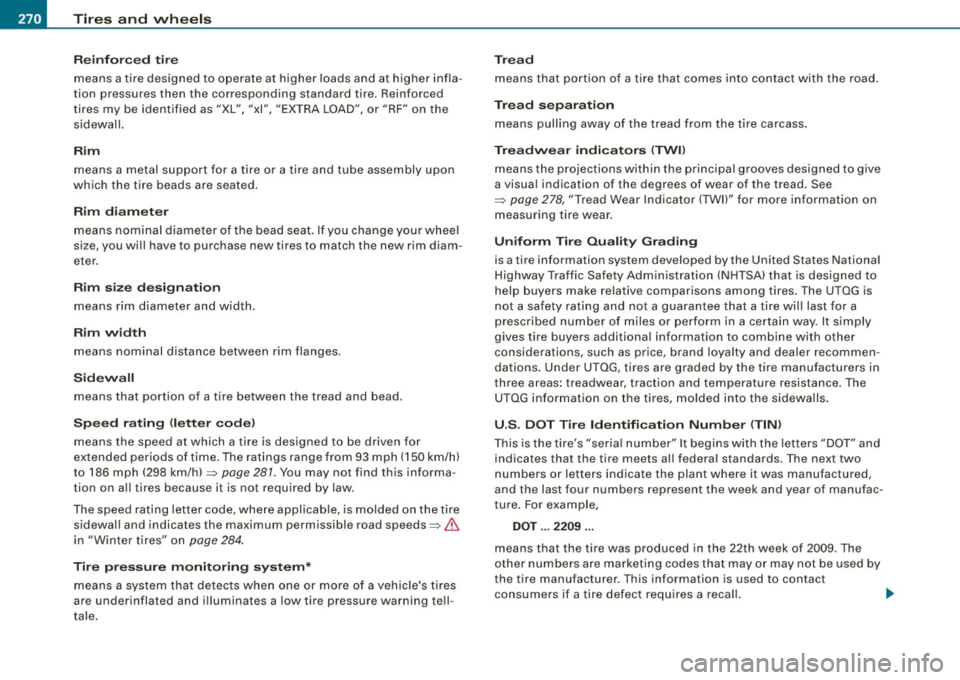
-~_T_ ir_e_ s_ a_ n_d _ w_ h_ e_e _l_s _________________________________________________ _
Rei nf orced tire
means a tire designed to operate at higher loads and at higher inf la
tion pressures then the corresponding standard tire. Reinforced
tires my be identified as "XL",
"xi", "EXTRA LOAD", or "RF" on the
sidewall.
Rim
means a metal support for a tire or a tire and tube assembly upon
which the t ire beads are seated.
R im di am eter
means nomina l diameter o f the bead seat. If you change your wheel
size, you wi ll have to purchase new tires to match the new rim diam
eter.
R im size des ig nati on
means rim diameter and width.
Rim width
means nominal distance between rim flanges .
Sidewall
means that portion of a tire between the tread and bead.
Speed rating (le tter code )
means the speed at which a tire is designed to be driven for
extended periods of time . The ratings range from 93 mph ( 150 km/h)
to 186 mph (298 km/h)~
page 281. You may not find this informa
tion on a ll tires because it is not required by law .
The speed rating letter code, where appl icable, is molded on the tire
sidewal l and indicates the maximum permissible road speeds~
&
in "Winter tires" on page 284 .
Tire pres su re m onitoring s yste m*
means a system that detects when one or more of a vehicle's tires
are underinflated and i lluminates a low tire pressure warning te ll
tale .
Trea d
means that portion of a tire that comes into contact with the road .
Trea d se parati on
means pulling away of the tread from the tire carcass .
Treadw ear indi cato rs (TWI)
means the projections within the princ ipal grooves designed to give
a visual indication of the degrees of wear of the tread. See
~ page 278, "Tread Wear Indicator (TWI)" for more informatio n on
measuring tire wear.
Uniform Tire Q uality Gra ding
is a tire information system developed by the United States National
Highway Traffic Safety Administration (N HTSA) that is designed to
help buyers make relative comparisons among tires. The U TQG is
not a safety rating and not a guarantee that a tire wil l last for a
prescribed number of miles or perform in a certain way. It simply
gives tire buyers additiona l information to combine wit h other
considerations, such as price, brand loyalty and dea ler recommen
dations. Under UTQG, tires are graded by the tire manufacturers in
three areas: treadwear, traction and temperature resistance . The
UTQG information on the tires, molded into the sidewalls.
U.S . D OT T ir e Ident ifi ca tion Num ber (T IN )
This is the tire's "serial number" It begins with the le tters "DOT" and
indicates that the tire meets all federa l standards . The next two
numbers or letters indicate the plant where it was manufactured,
and the last four numbers represent the week and year of manufac
ture. For example,
D OT ... 2 209 ...
means that the tire was produced in the 22th week of 2009 . The
other numbers are marketing codes that may o r may not be used by
the tire manufacturer . This information is used to contact
consumers if a tire defect requires a reca ll. -.,
Page 273 of 340
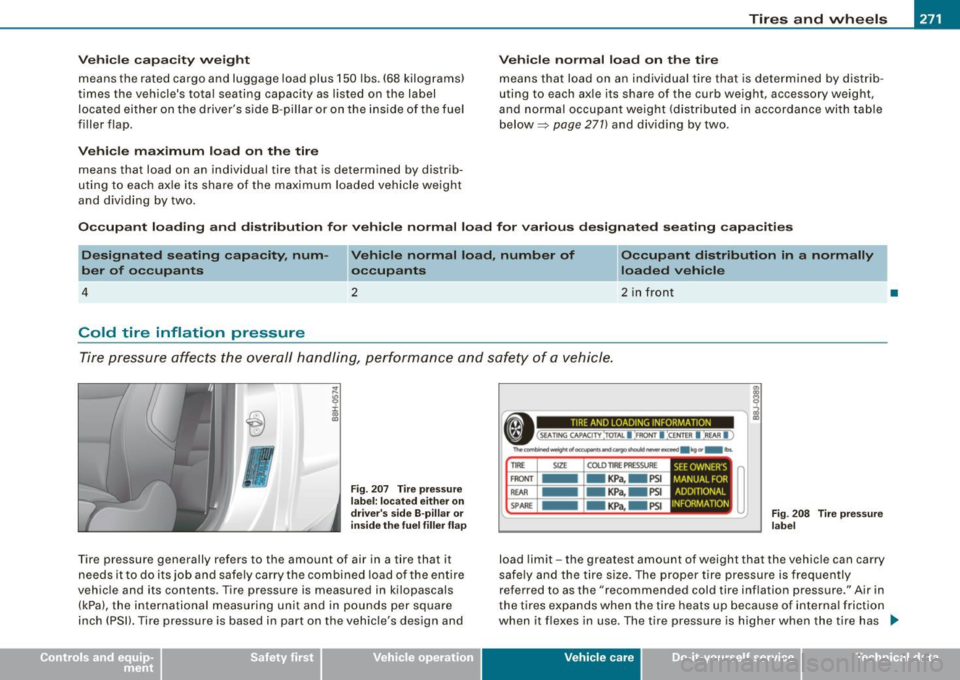
Tires and wh eels -
--------------------'
Vehicle capac ity wei ght
means the rated cargo and luggage load plus 150 lbs. (68 kilograms)
times the vehicle's tota l seating capacity as listed on the label
located either on the driver's side 8 -pil lar or on the inside of the fuel
filler flap.
V eh ic le max imum load on the tire
means that load on an individual tire that is determined by distrib
uting to each ax le its sha re of the maximum loaded vehicle weight
and dividing by two.
Vehi cle normal load on th e tire
means that load on an ind ividual tire that is determined by distrib
uting to each axle its share of the curb weight, accessory weight,
and normal occupant weight (distributed in accordance with table
below~
page 271) and dividing by two.
O ccup ant loading and di stribution for veh icle normal load for various designated seating capa citi es
Designated seating capa city , num- Vehicle normal load , number of Oc cupant distribution in a normally
loaded vehicle
ber of o
ccup ants occupants
-------------------4 2 2 in fr ont •
Cold tire inflation pressure
Tire pressure a ffects the overall handling, perform ance and safety of a vehicle .
Fig. 207 Tire pr essure
l a b el: loca ted e ithe r o n
driver 's side B- pillar or
in side the fuel fill er flap
Tire pressure generally refers to the amount of air in a tire that it
needs it to do its job and safely carry the combined load of the entire
vehicle and its contents. Tire pressure is measured in kilopascals (kPa), the internationa l measuring unit and in pounds per square
inch (PSI!. Tire pressure is based in part on the vehic le's design and
TIRE AND LOADING INFORMATION
• (SEATING CAPACITY :rorAI. I :FRONT I :CE NTER I :REAR I l
Thea,mthd""'91"~000,-ond""90shoulcl,-u
FRONT -KPa, -PSI
REAR -KPa, - PSI
SPARE -KPa, -PSI
MANUAL FOR
ADDITIONAL
INFORMATION SEE OWNER'S I
Fig . 2 0 8 Tire press ure
l a b el
load limit -the greatest amount of weight that the vehicle can carry
safe ly and the t ire size. The proper t ire pressure is frequently
referred to as the "recommended cold tire inflation pressure." Air in
the tires expands when the tire heats up because of interna l friction
when it flexes in use. The tire pressure is higher when the tire has ...
Vehicle care irechnical data
Page 274 of 340
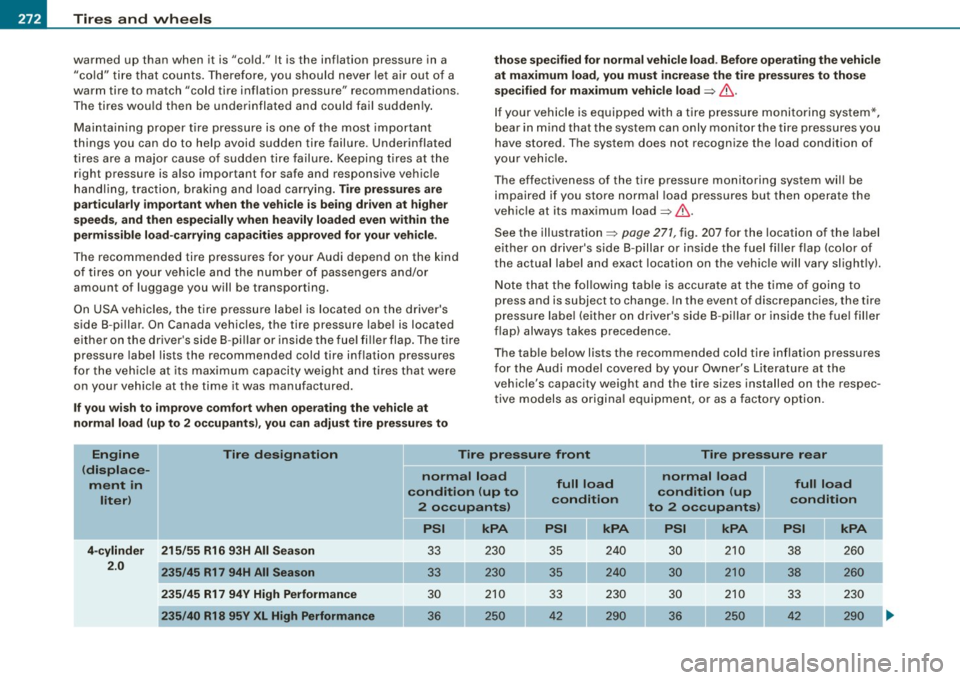
-Tires and wheels
P'U:1-------------------
warmed up than when it is "cold." It is the inflation pressure in a
"cold" tire that counts. Therefore, you should never let air out of a
warm tire to match "cold tire inflation pressure" recommendations .
The tires would then be underinflated and could fail suddenly.
Maintaining proper tire pressure is one of the most important
things you can do to help avoid sudden tire failure. Underinflated
tires are a major cause of sudden tire failure. Keeping tires at the
right pressure is also important for safe and responsive vehicle
handling, traction, braking and load carrying.
Tire pressures are
particularly important when the vehicle is being driven at higher
speeds, and then especially when heavily loaded even within the
permissible load-carrying capacities approved for your vehicle .
The recommended tire pressures for your Audi depend on the kind
of tires on your vehicle and the number of passengers and/or
amount of luggage you will be transporting.
On USA vehicles, the tire pressure label is located on the driver's
side B-pillar . On Canada vehicles, the tire pressure label is located
either on the driver's side B-pillar or inside the fuel filler flap. The tire
pressure label lists the recommended cold tire inflation pressures
for the vehicle at its maximum capacity weight and tires that were
on your vehicle at the time it was manufactured.
If you wish to improve comfort when operating the vehicle at
normal load (up to 2 occupants), you can adjust tire pressures to
-
those specified for normal vehicle load. Before operating the vehicle
at maximum load, you must increase the tire pressures to those
specified for maximum vehicle load
=> & .
If your vehicle is equipped with a tire pressure monitoring system *,
bear in mind that the system can only monitor the tire pressures you
have stored. The system does not recognize the load condition of
your vehicle.
The effectiveness of the tire pressure monitoring system will be
impaired if you store normal load pressures but then operate the
vehicle at its maximum load=>&.
See the illustration =>
page 271, fig. 207 for the location of the label
either on driver's side B-pillar or inside the fuel filler flap (color of
the actual label and exact location on the vehicle will vary slightly).
Note that the following table is accurate at the time of going to
press and is subject to change. In the event of discrepancies, the tire
pressure label (either on driver's side B-pillar or inside the fuel filler
flap) always takes precedence .
The table below lists the recommended cold tire inflation pressures
for the Audi model covered by your Owner's Literature at the
vehicle's capacity weight and the tire sizes installed on the respec
tive models as original equipment, or as a factory option.
Engine
(displace
ment in liter) Tire designation
Tire pressure front Tire pressure rear
4-cylinder
2.0 215/55 R16 93H All Season
235/45 R17 94H All Season
235/45 R17 94Y High Performance
235/40 R18 95Y XL High Performance
normal load
condition (up to
2 occupants)
PSI
33
33
30
36
kPA
230
230
210
250
full load
condition
PSI
35
35 33
42
II kPA
240
240
230
290
normal load
condition (up
to 2 occupants)
PSI
30
30
30
36
JI kPA
210
210
210
250
11 full load
condition
PSI
38
38
33
42
JI kPA
260
260
230
290
I
Page 275 of 340
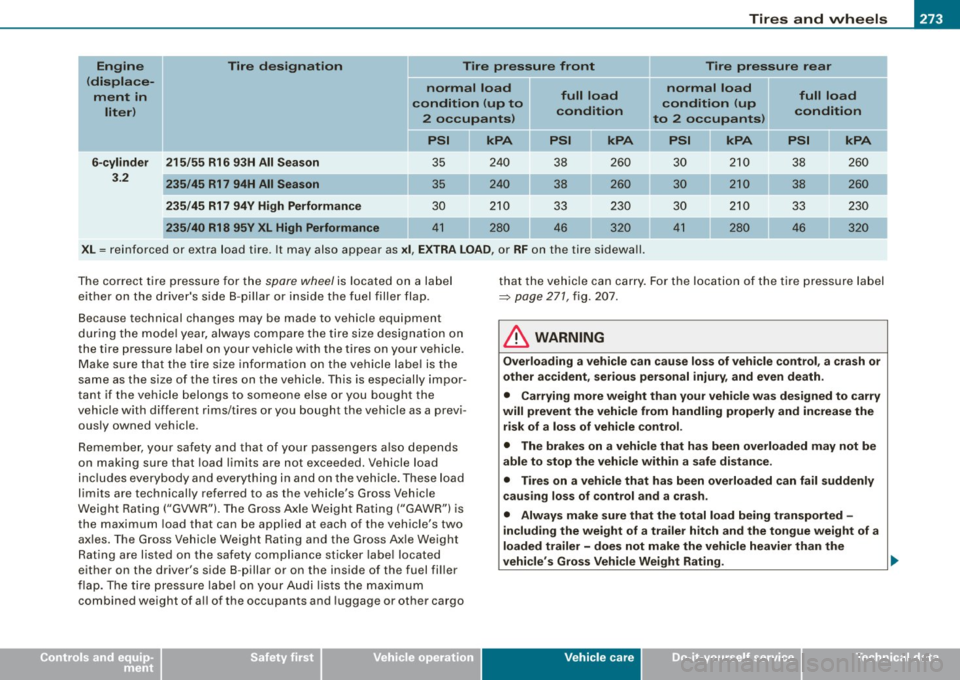
Tires and wheels -
----------------
•
Engine Tire designation Tire pressure front Tire pressure rear
(displace- normal load normal load
ment in full load
full load
liter ) c
ondit ion (up to
condition c
ondition (up
condition
2 occupants ) to 2 occupants)
PSI kPA PSI kPA PSI kPA PSI kPA
6 -cylinder 215 /55 R16 93H All Season 35 240
38 260
30 2
10
38 260
3.2
235/45 R17 94H All Season 35 2
4 0
38 260 30 2
10
38 260
235/45 R17 94V High Performance 30 2 10 3 3 230 30 2 10 33 230
235 /40 R18 95V XL High Performance 41 280 46 320 41 280 4 6 320
XL= reinforced or extra load tire. It may also appear as x i, EXTRA LOAD , or RF on the tire sidewa ll.
The correct tire pressure for the
spare wheel is located on a label
either on the dr iver's side B-pilla r or i nside the fuel filler flap.
Because technical changes may be made to vehicle equipment
dur ing the mode l year, a lways co mpare the tire size designatio n on
the tire pressure label on your vehicle with the tires on your vehicle .
Make sure t hat the tire s ize informa tion o n the vehi cle labe l is the
same as the size of the tires on the vehicle . This is especially impor
t a nt if th e ve hicle belo ngs to someone else or you bough t the
vehic le with different rims/tires or you bought the vehicle as a previ
ously owned vehicle.
Re member, your safety and that of your passeng ers a ls o depends
on making sure that load limits are not exceeded. Vehicle load
inc lude s every body and everyt hin g i n and o n the vehic le . These load
limits are techn ically referred to as the vehicle's Gross Vehic le
Weight Ra tin g ("GVWR") . The Gross Axle Weig ht Ra ting ("GAWR") is
the maximum load that can be applied at each of the veh icle's two
ax les . The Gross Vehic le W eight Rating and the Gross Ax le Weight
Rating are listed on the safety compliance sticker label located
either on the driver's s ide 8 -pillar or on the inside of the fuel fi ller
fl ap. T he ti re pressure labe l on your Aud i lists the max imum
combined weight of a ll of the occupants and luggage or other cargo that the vehicle can car
ry. Fo r the l ocat io n of the tire pressure la bel
=> page 271, fig. 207.
LJ}. WARNING
Overload ing a vehicle can cause loss of vehi cle cont rol , a crash or
other ac cident , serious per sonal injury , and even death .
• Carrying more weight than your vehicle wa s designed to carry
will prevent the vehicle from handling properly and increase the
risk of a loss of vehicle control .
• The brakes on a vehicle that has been overloaded may not be
able to stop the vehi cle within a safe dist ance.
• Tires on a vehicle that has been overloaded can fail suddenly
cau sing lo ss of control and a crash .
• Always make sure that the total load being transported -
including the weight of a trailer h itch and the tongue weight of a
loaded trailer -does not make the vehicle heavier than the
vehi cle 's Gross Vehicle Weight Rating . .,,_
Vehic le care
Page 276 of 340
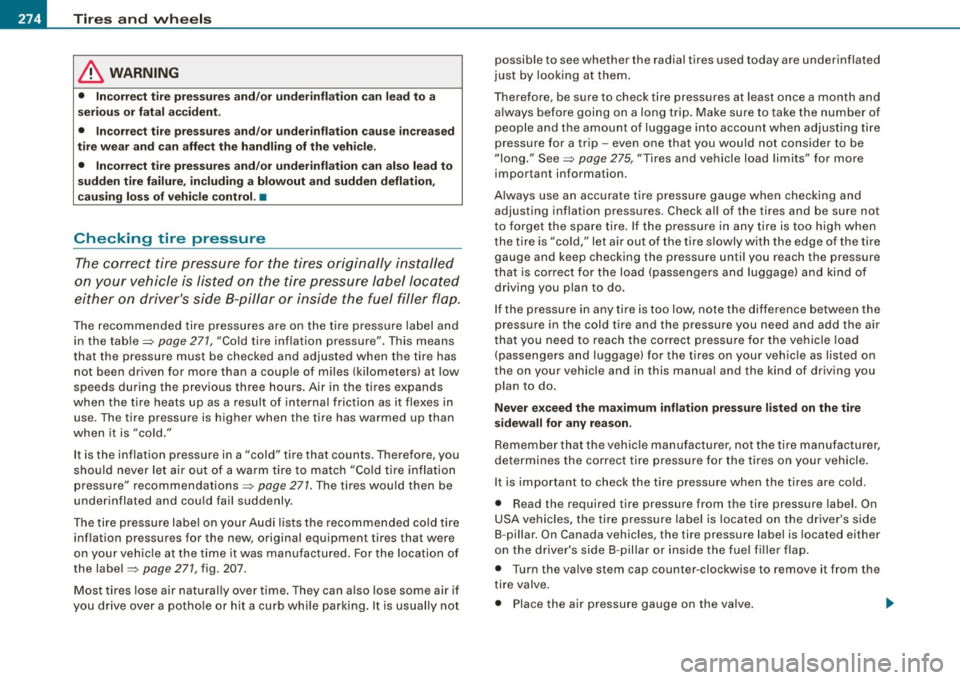
lffll,.___T_ ir_e_ s _ a_ n_d_ w_ h_ e_e _ l_s _________________________________________________ _
& WARNING
• Incorrect tire pressures and/or underinflation can lead to a
serious or fatal accident.
• Incorrect tire pressures and/or underinflation cause increased
tire wear and can affect the handling of the vehicle.
• Incorrect tire pressures and/or underinflation can also lead to
sudden tire failure, including a blowout and sudden deflation,
causing loss of vehicle control. •
Checking tire pressure
The correct tire pressure for the tires originally installed
on your vehicle is listed on the tire pressure label located
either on driver's side 8-pillar or inside the fuel filler flap.
The recommended tire pressures are on the tire pressure label and
in the table=>
page 271, "Cold tire inflation pressure ". This means
that the pressure must be checked and adjusted when the tire has
not been driven for more than a couple of miles (kilometers) at low
speeds during the previous three hours. Air in the tires expands
when the tire heats up as a result of internal friction as it flexes in
use. The tire pressure is higher when the tire has warmed up than
when it is "cold."
It is the inflation pressure in a "cold " tire that counts . Therefore, you
should never let air out of a warm tire to match "Cold tire inflation
pressure" recommendations=>
page 271. The tires would then be
underinflated and could fail suddenly.
The tire pressure label on your Audi lists the recommended cold tire
inflation pressures for the new, original equipm ent tires that were
on your vehicle at the time it was manufactured. For the location of
the label =>
page 271, fig. 207.
Most tires lose air naturally over time. They can also lose some air if
you drive over a pothole or hit a curb while parking. It is usually not possible to see whether the radial tires used today are underinflated
just by looking at them.
Therefore, be sure to check tire pressures at least once a month and always before going on a long trip. Make sure to take the number of
people and the amount of luggage into account when adjusting tire
pressure for a trip -even one that you would not consider to be
"long." See=>
page 275, "Tires and vehicle load limits" for more
impor tant information .
Always use an accurate tire pressure gauge when checking and
adjusting inflation pressures . Check all of the tires and be sure not
to forget the spare tire. If the pressure in any tire is too high when
the tire is "cold," let air out of the tire slowly with the edge of the tire
gauge and keep checking the pressure until you reach the pressure
that is correct for the load (passengers and luggage) and kind of
driving you plan to do.
If the pressure in any tire is too low, note the difference between the
pressure in the cold tire and the pressure you need and add the air
that you need to reach the correct pressure for the vehicle load
(passengers and luggage) for the tires on your vehicle as listed on
the on your vehicle and in this manual and the kind of driving you
plan to do.
Never exceed the maximum inflation pressure listed on the tire
sidewall for any reason.
Remember that the vehicle manufacturer, not the tire manufacturer,
determines the correct tire pressure for the tires on your vehicle.
It is important to check the tire pressure when the tires are cold.
• Read the required tire pressure from the tire pressure label. On
USA vehicles, the tire pressure label is located on the driver's side
B-pillar . On Canada vehicles, the tire pressure label is located either
on the driver's side 8 -pillar or inside the fuel filler flap.
• Turn the valve stem cap counter-clockwise to remove it from the
tire valve.
• Place the air pressure gauge on the valve. .,_
Page 277 of 340

Tires and wheels -
----------------
•
• The tire pressures should only be checked and adjusted when
t he t ires are co ld . The s lightly raised press ures of warm tires must
not be reduced .
• Adjust t he tire p re ssure to the load you are carrying.
• Reinstall the va lve stem cap on the valve.
When should I check the tire pressure?
The correc t tire p re ssur e is espec ially i mportant at high speeds. The
pressure should there fore be c hecked at least once a month and
a lways before starting a journey. Do not forget to check the tire pres
su re for t he spare whee l::::>
page 291.
When should I adjust the tire pressures?
Adjust the ti re pressur e to the load you are carrying. A fter chang in g
a wheel
or replacing whee ls you have to adj ust t he t ire pressure s on
a ll whee ls. In addition, o n ve hicles w ith t ire pressure monito ring
system * you must then store the new tire pressures in the system
=> page 41.
& WARNING
Incorrect tire pres sures and /or underinflation can lead sudden tire
failure, loss of control , collision, serious personal injury or even
death .
• When the warning symbol ( appears in the instrument
cluster , stop and inspect the tires .
• Incorrect tire pressure and /or underinflation can cause
increased tire wear and can affe ct the handling of the vehicle and
stopping ability .
• Incorre ct tire pressures and /or underinflat ion can also lead to
sudden tire failure, including a blowout and sudden deflation,
causing loss of vehi cle control.
• The driver is responsible for the correct tire pressures for all
tires on the vehicle . The appli cable pre ssure values are located on
a sticker on the driver 's side 8-pillar or on the inside of the fuel
filler flap .
& WARNING (continued )
• Only when all tires on the veh icle are filled to the correct pres
s ure, the tire pressure monitoring system * can work correctly .
• The use of incorrect tire pressure values can lead to accidents
or other damage . Therefore it is essential that the driver observe
the specified tire pressure values for the tires and the correct pres
sures for the function of the tire pressure monitoring system*.
• Alway s inflate tires to the recommended and corre ct tire pres
sure before driving off.
• Driving with underinflated tires bend more , letting them get
too hot resulting in tread separation , sudden tire failure and loss
of control.
• Excessive speed and /overloading can cause he at build -up ,
sudden tire failure and loss of control.
• If the tire pressure is too low or too high , the tires will wear
prematurely and the vehicle will not handle well.
• If the tire is not flat and you do not have to change a wheel
immediately, drive at reduced speed to the nearest service station
to che ck the tire pressure and add air as required .
0 Note
Driving without valve stem caps can cause damage to the tire
valves. To p revent this, a lways make sure tha t factory installe d va lve
stem caps on al l wheels are securely mounted on the va lve .
<£> For the sake of the environment
Underinflated tires wi ll a lso increase the fue l consumption. •
Tires and vehicle load limits
There are limits to the amount of load or weight that any vehic le and
any tire can carry. A vehicle that is overloa ded wil l n o t handle well _,.
Vehic le care
Page 278 of 340
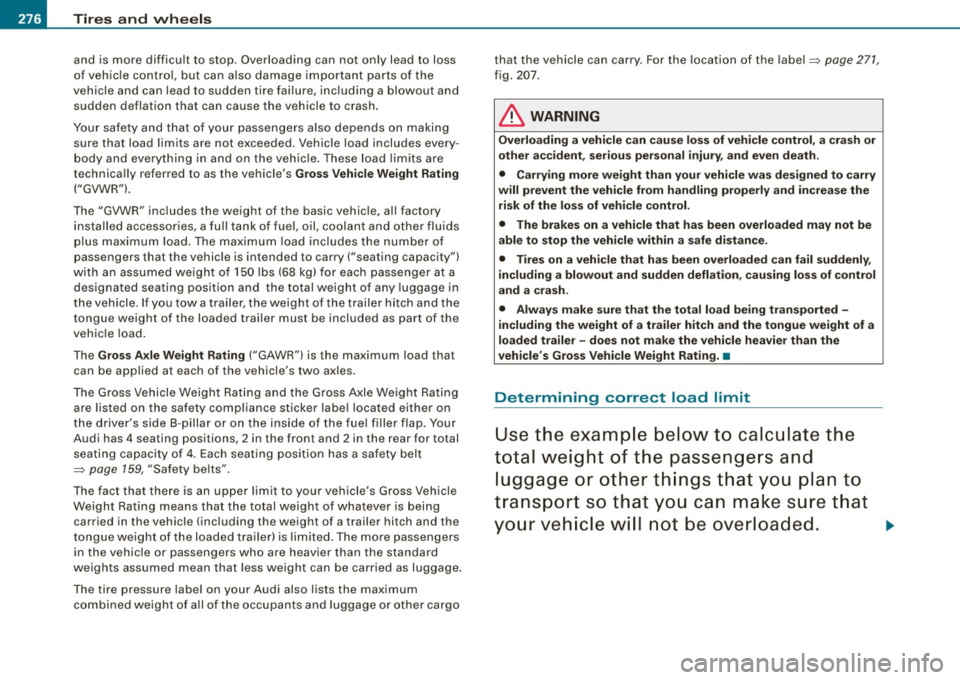
-~_T_ ir_e_ s_ a_ n_d _ w_ h_ e_e _l_s _________________________________________________ _
and is more difficult to stop. Overloading can not only lead to loss
of vehic le contro l, but can also damage important parts of the
vehic le and can lead to sudden tire failure, including a blowout and
sudden deflation that can cause the vehicle to crash .
Your safety and that of your passengers also depends on making sure that load limits are not exceeded . Vehicle load includes every
body and everything in and on the veh icle . These load lim its are
technically referred to as the vehicle's
G ross Vehicle Weight R ating
("GVWR").
The "GVWR" includes the weight of the basic vehic le, all factory
installed accessories, a ful l tank of fuel, oil, coolant and other fluids
p lus maximum load. The maximum load includes the number of
passengers that the vehicle is intended to carry ("seating capacity")
with an assumed we ight of 150 lbs (68 kg) for each passenger at a
designated seating position and the total weight of any luggage in
t he vehicle. If you tow a trai ler, the weight of the trailer hitch and the
tongue weight of the loaded trai ler must be included as part of the
vehic le load .
T he
G ros s Axle Weight Rating ("GAWR") is the maximum load that
can be applied at each of the vehicle's two axles .
The Gross Vehicle Weight Rat ing and the Gross Axle Weight Rating
are listed on the safety compliance sticker labe l located either on
the d river's side B -pillar o r on t he inside of the f ue l fi ller flap. Yo ur
Audi has 4 seating positions, 2 in the front and 2 in the rear for total
seating capaci ty of 4. Each seating posi tion has a safety belt
=>
page 159, "Safety be lts" .
T he fact that there is an upper limit to your vehicle's Gross Vehicle
Weight Rating means that the total weight of whatever is being carried in the vehicle (including the weight of a trailer hitch and the
tongue weigh t of the loaded trailer) is lim ite d. The more passengers
in the vehicle or passengers who are heavier than the standard
weights assumed mean that less weight can be carried as luggage.
The tire pressure labe l on your Audi also lists the maximum
combined weight of a ll of the occupants and luggage or othe r cargo that the vehicle can carry
. For the location of the label=>
page 271,
f ig. 207 .
& WARNING
Overloading a vehicle can cau se lo ss of vehicle control , a cra sh or
other a ccident , seriou s personal injury , and even de ath .
• Carrying more weight th an your vehi cle w as designed to ca rry
will prevent the vehi cle from handling properly and in cre ase the
ri sk of the lo ss of vehicle control.
• The brakes on a veh icle th at ha s been overloaded ma y not be
able to stop the vehicle within a safe distance .
• Tire s on a vehicle that has been overloaded can fail suddenly,
i ncluding a blowout and sudden defla tion , cau sin g los s of control
and a crash .
• Alwa ys make sure that the tot al l oad be ing tran sported -
including the weight of a trai ler hit ch and the tongue weight of a
loaded trailer -does not m ake the vehicle heavie r than the
v ehicle 's Gro ss Vehicle Weight Rat ing .•
Determining correct load limit
U se th e exa mple below to calculat e the
total weight of the passengers and luggage or other things that you plan to
tran sport so that you can make sure that
your vehi cle will n ot be ov erlo ad ed.
~
Page 279 of 340
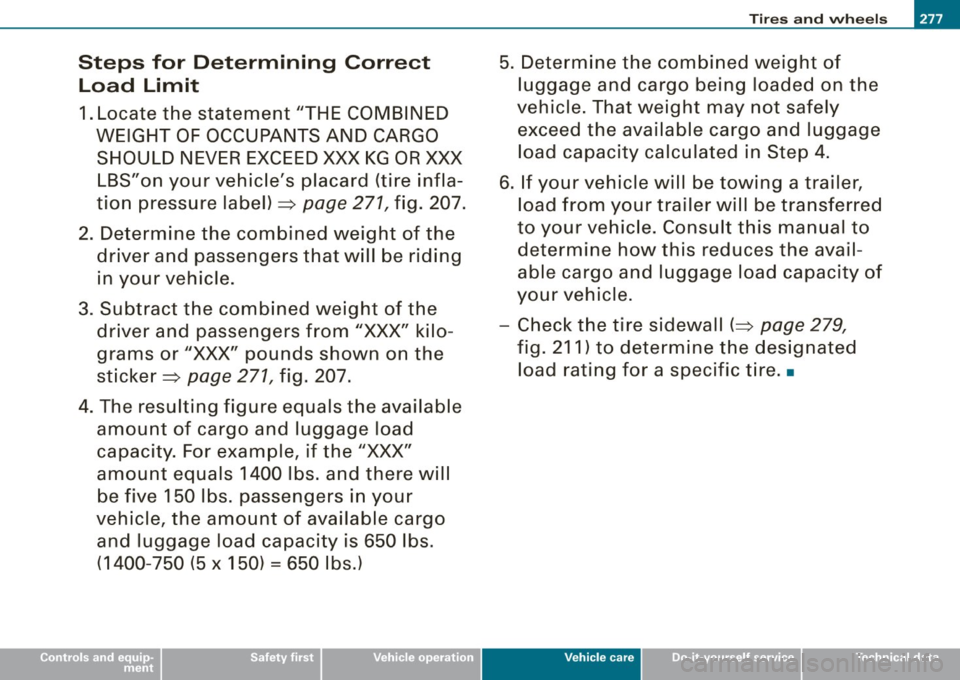
Steps for Determining Correct Load Limit
1. Locate the statement "THE COMBINED
WEIGHT OF OCCUPANTS AND CARGO SHOULD NEVER EXCEED XXX KG OR XXX
LBS"on your vehicle's placard (tire infla
tion pressure label)=>
page 271, fig. 207.
2. Determine the combined weight of the
driver and passengers that will be riding
in your vehicle.
3. Subtract the combined weight of the
driver and passengers from
"XXX" kilo
grams or
"XXX" pounds shown on the
sticker=>
page 271, fig. 207.
4. The resulting figure equals the available
amount of cargo and luggage load
capacity. For example, if the
"XXX"
amount equals 1400 lbs. and there will
be five
150 lbs. passengers in your
vehicle, the amount of available cargo
and luggage load capacity is
650 lbs.
( 1400- 750 (5 x 150) = 650 I bs.)
Tires and wheels 1111111
5. Determine the combined weight of
luggage and cargo being loaded on the
vehicle. That weight may not safely exceed the available cargo and luggage
load capacity calculated in Step
4.
6. If your vehicle will be towing a trailer,
load from your trailer will be transferred
to your vehicle. Consult this manual to
determine how this reduces the avail
able cargo and luggage load capacity of
your vehicle.
- Check the tire sidewall (=>
page 279,
fig. 211) to determine the designated
load rating for a specific tire. •
Vehic le care
Page 280 of 340
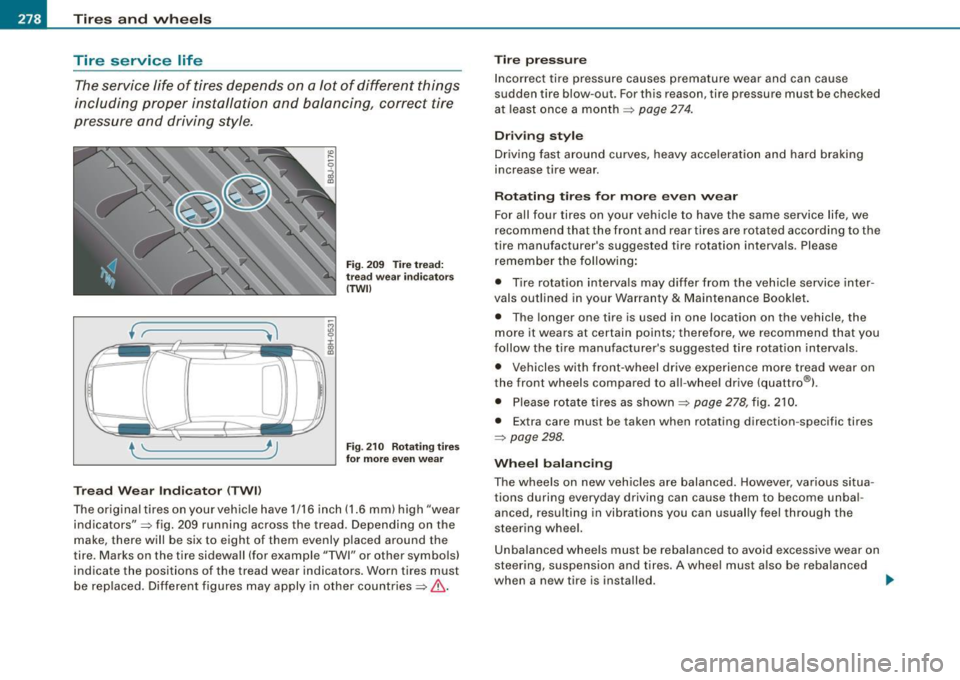
___ T_ i_ r_e _s_ a_ n_ d_ vv_ h_ e_ e _ ls _________________________________________________ _
Tire service life
The service life of tires depends on a lot of different things
including proper installation and balancing, correct tire
pressure and driving style .
(r------,')
l "------J)
Tread Wear Indicator ( TWll
ij
:c ., m
Fig. 209 Tire tre ad:
t read wear ind ica to rs
(TW IJ
Fig . 2 10 Rot ati ng tire s
for mo re even w ear
The orig inal tires on your vehic le have 1 /16 inch (1.6 mm) high "wear
indicators "~ fig. 209 running across the tread . Depending on the
make , there will be six to eight of them evenly p laced around the
tire . Marks on the tire sidewall (for example "TWI" or other symbo ls)
indicate the positions of the tread wear indicators . Worn tires must
be replaced. Dif ferent figures may apply in other countries~&.
Tire pre ssure
Incorrect tire pressure causes premature wear and can cause
sudden tire blow-out . For this reason , tire pressure mus t be checked
at least once a month~
page 274.
Driving style
Driving fast around curves, heavy acce leration and hard braking
increase tire wear .
Rotating t ires for more even wear
For all four tires on your vehicle to have the same service life, we
recommend that the front and rear tires are rota ted according to the
tire manufacturer's suggested tire rotation interva ls . Please
remember the following:
• Tire rotation interva ls may differ from the vehicle service inter
vals out lined in your Warran ty
& M aintenance Booklet .
• The longer one tire is used in one locat ion on the vehicle, the
more it wears at certain po ints; therefore, we recommend that you
follow the tire manufacturer 's suggested t ire rotation intervals .
• Vehicles with front -wheel drive experience more tread wear on
the front wheels compared to al l-wheel drive (quattro®) .
• Please rotate tires as shown ~
page 278, fig. 210 .
• Extra care must b e taken wh en rotat ing dir ection -specific tires
~ page 298.
Wheel balan cing
The wheels on new vehicles are balanced. However, various situa
tions during everyday dr iving can cause them to b ecome unbal
anced, resulti ng in vibra tions you can usually feel through the
ste ering whee l.
Unbalanced wheels must be rebalanced to avoid excessive wear on
steering , suspension and tires . A wheel must also be reba lanced
when a new tire is installed.
~